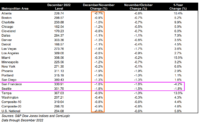UK Inflation comes out lower. But was this just the warm up?
The big figure of the week is from the Federal Open Markets Committee which is currently meeting to decide US interest rates. We will get the results of that meeting at 6pm (GMT) this evening.
No change is expected, however, the committee will release its latest ‘dot plots’ which are their expectations as to where interest rates are likely to go over the next few years. This could prove to be very interesting.
Before we get onto that though, the UK had some good news this morning. UK inflation fell more sharply than expected to the lowest level since September 2021.
This keeps the Bank of England on track to reduce interest rates later this year.
The Consumer Prices Index rose 3.4% in February from a year earlier, slower than the 4% pace the month before, the Office for National Statistics said Wednesday. The figure was lower than the median of 3.5% predicted by economists and the BOE.
BoE Governor Andrew Bailey has signalled he needs to see further evidence that price pressures will fall back sustainably to the 2% target before easing off on the benchmark lending rate. However, we believe that could well happen over the next two months.
BoE officials are expected to leave interest rates at a 16-year high of 5.25% on Thursday, with financial markets only fully pricing in the first cut in August.
As we’ve said a few times, we feel that it could, and should, be sooner. Not a lot sooner mind you, but June or July is definitely on the cards.
“Inflation is heading in the right direction and should fall below the Bank of England’s 2% target sometime in the Spring,” said Alpesh Paleja, lead economist at the CBI. “However, the path beyond this is likely to be bumpy. Shifting base effects mean that it will likely rise back above 2% later in the year.”
The easing in the annual inflation rates reflected downward contributions from nine divisions, partially offset by upward contributions from two. Large downward effects from food and non-alcoholic beverages, and restaurants and hotels were partially offset by a large upward effect from housing and household services.
Food and non-alcoholic beverages
Prices for food and non-alcoholic beverages rose by5.0% in the year to February 2024, down from 7.0% in January. The February figure is the lowest annual rate since January 2022. The rate has eased for the eleventh consecutive month from a recent high of 19.2% in March 2023, the highest annual rate seen for over 45 years.
Prices rose by 0.2% between January and February 2024, compared with a monthly rise of 2.1% a year ago. Prices have been relatively high but stable since early summer 2023, rising by less than 2% over the nine months between May 2023 and February 2024. This compares with a sharp rise of around 22% seen over the previous 14 months between March 2022 and May 2023.
Restaurants and hotels
The annual inflation rate for restaurants and hotels was 6.0% in February 2024, down from 7.1% in January, and the lowest rate since February 2022. On a monthly basis, prices rose by 1.0% between January and February 2024, compared with a rise of 2.0% between the same two months a year ago.
Housing and household services
The overall easing in the inflation rate was partially offset by an upward effect from housing and household services, whose annual rate was 2.9% in February 2024, up from 2.5% in January. This compares with a recent peak of 11.8% observed in January and February 2023.
The annual rate for actual rentals for housing was 6.9% in the year to February 2024, up from 6.5% in January, with the rise between months caused by price increases from privately rented properties.
Now onto the FED and the interest rate decision to come
Bond traders are stepping up short bets against Treasuries and buying derivatives to protect against a sell-off, positioning for the risk that the Federal Reserve will dial back the market’s expectations for interest-rate cuts this year.
While the US central bank is all but certain to hold rates steady Wednesday, trading data points to growing concern that its new forecasts will show increased reticence to ease monetary policy.
The December forecasts showed policymakers were pencilling in three quarter-point cuts in 2024, but since then the economy has continued to exhibit surprising strength and inflation has held above the Fed’s target.
“The bond market is bracing for a hawkish Fed message Wednesday,” Bryce Doty, senior portfolio manager at Sit Investment Associates, said in a note to clients.
Bond yields were little changed on Wednesday having risen this year to saddle investors with fresh losses, as expectations faded that the Fed would ease policy sharply.
In late December, futures traders were pricing in virtual certainty the central bank would start cutting rates by Wednesday’s meeting and make a total of about six such moves by the year’s end.
A change in the dot plot should also negatively impact the equity market; but right now the US market – or more accurately about 10 US companies – is hovering up capital from investors all over the world which seems to not only be holding it up, but adding to its value.
What will be the catalyst to break this, it’s hard to say. It is unlikely to be the simple ‘dot plot’ this evening, and when it hits it will no doubt have been ‘obvious’, but for now, the market seems steady.
One thing to note is there is now a new red light flashing when it comes to commercial real estate. An obscure investment product used to finance risky projects is facing unprecedented stress as borrowers struggle to repay loans tied to commercial property ventures. Known as commercial real estate collateralized loan obligations (CRE CLO), they bundle debt that would usually be seen as too speculative for conventional mortgage-backed securities.
In just the last seven months, the share of troubled assets held by these niche products surged four-fold — rising by one measure to more than 7.4%. For the hardest hit, delinquency rates are in the double digits. That’s left major players in the $80 billion market rushing to rework loans while short sellers ramp up attacks on publicly traded issuers.
The dollar
Oops, Wall Street has gotten the dollar wrong this year. Or “gloriously wrong,” as Vishnu Varathan at Mizuho Bankputs it.
While a gauge of the dollar has jumped more than 2% in 2024, and the US currency has beaten most of its major peers, consensus was calling for the opposite to happen.
The bet was that virtually every G10 currency would gain against the dollar on expectations the Fed would begin an aggressive cycle of rate cuts. Despite getting wrong-footed by the moves so far this year, dollar bears remain the market’s dominant voice and asset managers are clinging to wagers that the dollar will fall. That’s a bet they’ve had since 2017.
For now, we will await the FOMC meeting this evening and see what scraps the committee throws us. Will they dial back expectations? The general consensus is that they will.
For more insight visit www.tppglobal.io
Contributor posts published on Zero Hedge do not necessarily represent the views and opinions of Zero Hedge, and are not selected, edited or screened by Zero Hedge editors.
Loading…
[ad_2]
Source link


